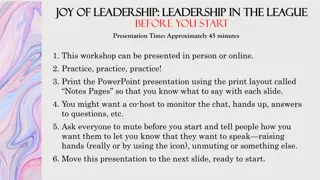Effective Boss Leadership: Insights and Strategies
Employees thrive under great bosses who prioritize motivation, respect, and clear communication. Unfortunately, many workers today feel disengaged and lack understanding of their company's goals. To be a successful boss, one must possess the aptitude, desire, and capacity for the role. Emotional and intellectual capacities are crucial for fostering a positive work environment and strategic decision-making.
Download Presentation

Please find below an Image/Link to download the presentation.
The content on the website is provided AS IS for your information and personal use only. It may not be sold, licensed, or shared on other websites without obtaining consent from the author.If you encounter any issues during the download, it is possible that the publisher has removed the file from their server.
You are allowed to download the files provided on this website for personal or commercial use, subject to the condition that they are used lawfully. All files are the property of their respective owners.
The content on the website is provided AS IS for your information and personal use only. It may not be sold, licensed, or shared on other websites without obtaining consent from the author.
E N D
Presentation Transcript
How To Be A Great Boss By Gino Wickman and Rene Boer Book Summary and Discussion 1
Highly motivated employees enjoy both personal and professional satisfaction from what they do. They work hard... They enjoy the people they work with; They feel respected by their boss; They feel their work is making contribution to customers lives; They find the challenge of their work matches their abilities; And, they know why they go to work each day - Matthew Kelly Great bosses earn the respect of those they lead; they don't take it for granted. Sadly, too many bosses don't get it. They think their title empowers them with unquestioned authority to act in whatever manner they deem necessary. - Gino Wickman Management is not what you do to someone; It's what you provide for someone. - Gino Wickman 2
State of The Workforce Gallup Data: 31.5% of full-time American workers are engaged at their jobs 17.5% of American workers are actively disengaged at work Therefore, 51% of American workers are not engaged at work. These employees meet the minimum requirements, but they don't view their jobs as a major component of their daily lives. Harris Poll: 39% of employees have no idea of their company's goals and objectives. 47% are unfamiliar with the state of their company's performance 44% don't understand how the role they play helps the organization meet its goals 3
Three Requirements to Be A Great Boss You Must 1. Get it - heavy aptitude, natural ability, and thorough understanding of the ins and outs of the job; 2. Want it - sincerely desire the role; 3. Have the Capacity to do it - possess the emotional, intellectual, physical, and time capacity to do the job 4
Four Types of Capacity To Do A Great Job Emotional Capacity The heart to feel what others are feeling, the ability to walk a mile in their shoes, to be open and honest with yourself and others, the willingness to be real and connect with others, to be humbly confident, and to be self aware enough to know how you are influencing people Intellectual Capacity The brains do critical thinking, solve complex problems, predict, prioritize, and planned, along with the ability to conceptualize, strategized, and systematize how best to do things while orchestrating human resources 1. 2. 5
Four Types of Capacity To Do A Great Job (Cont d) Physical Capacity The stamina, energy, and tenacity to do what it takes to finish what you start, to pour it on when necessary, to devote the time and effort to master your craft, to do the work, and to get your hands dirty when necessary. Time Capacity The self discipline to use your time effectively, to avoid the tyranny of urgency, to structure, prioritized, organized, and delegate in a way that frees up and optimizes the most precious resource of all - your time 3. 4. 6
The Delegate and Elevate Process Step One: List all the business-related activities that you do during the course of a day, week, and month period write them down in a journal or notebook .Be patient and detailed. Step Two: After completing your list of business-related activities, compare it to the sample of boss related activities provided on EOS (next slide) Step Three: When you're satisfied that you have a complete list of all your activities, use the Delegate and Elevate Model to place each activity into one of the four quadrants. Please be honest with yourself. Step Four: In the four quadrants, examine where you placed the boss related activities and tasks specific to dealing with direct reports. Most of the these items (80%) should be in the top two quadrants Step Five: If you cannot accomplish all the business activities you listed in the time you have, then you have time-capacity issue. You need to Delegate and Elevate the activities in the bottom two quadrants that are occupying too much of your time. 7
Sample List of Boss-Related Activities Activities Dealing with technical skill, experience and expertise Activities Dealing with Direct Reports achieving goals being in meetings recognizing and rewarding brainstorming building systems performance reviews Developing financial analysis coaching subordinates Forecasting strategic planning directing people leading innovation meeting deadlines training managing workflow assigning tasks mediating disputes networking making presentations Listening paying bills booking travel managing conflict problem solving managing projects mentoring purchasing vendor relations facilitating meetings raising capital customer relations Firing people researching Reporting Delegating receiving legal documents receiving invoices scheduling meetings responding to emails signing checks negotiating software stuff hardware stuff sourcing candidates organizing speaking to groups blocks come away papers writing emails reading trade publications building key relationships strategic initiatives 8
You don't always have the luxury of delegating all the things that you do. However, to leverage your emotional, intellectual, physical, and time capacity to do the job, you must have a plan to delegate items in the bottom two quadrants. You can't be great at everything, and you'll never have the time to become a great boss if you don't let go of the things that bog you down. AND You're doing your team a favor for several reasons. First, you are freeing up more of your time to spend with them, ensuring they feel more valued. You're giving them more responsibility and more autonomy. You'll stop being a bottleneck to those that report to you. Best of all, your people may be more competent than you at doing the things that you've delegated to them. 10
Most Common Reasons Bosses Give For Not Delegating 1. Being good at these activities got me promoted in the first place. 2. I have no one to delegate to. 3. It takes too much time for me to train someone. 4. I find that it's faster and easier to do it myself. 5. I wouldn't ask anyone to do anything I wouldn't do myself. 6. No one can do it as well as me. 7. It's too complicated to explain to them. 8. I spent too much time fixing their mistakes. Great bosses appreciate the return on investing time in their people is exponential to the results that it reaps. Leading and managing people is the number one role for a boss. You can't escape that fact. 11
Putting Great People In The Right Seat The right people are at or above the bar on Core Values The right seat means they have three yeses for Get It, Want It, and Capacity To Do It. The People Analyzer is the tool used to assess both the Right People and the Right Seat. The Bar within your People Analyzer defines your minimum acceptable standard for Great People 13
Four People Issues that you will have to deal with as a boss 1. Right Person, Right Seat 2. Right Person, Wrong Seat 3. Wrong Person, Right Seat 4. Wrong Person, Wrong Seat If you like many bosses, you are spending most of your time with Wrong Seat issues ... Meanwhile, the Wrong People are undermining everything you're trying to do. Sadly, because you have to focus so much attention on these hires, the Right People in the Right Seats get very little of your time. 14
Four Truths You Must Embrace To Be A Great Boss 1. Being a great boss can be simple (don t overcomplicate it) 2. Your style does not have to change (just be yourself when your authentic it builds trust) 3. You must genuinely care about your people (you can t fake it - people will know if you care about them) 4. You must want to be great (you must be willing to invest the time necessary continuously improve yourself - for your business to grow you must grow) 15
Leadership + Management = Accountability Leadership Working on the business Clear direction Creating the opening Thinking Management Working in the business Clear expectations Communication Doing 16
The Five Leadership Practices 1. 2. Giving Clear Direction (e.g., Vision Traction Organizer) Providing the Necessary Tools (e.g., Delegate and Elevate, People Analyzer, etc.) Letting Go of the Vine (stop holding your people back) Acting with the Greater Good in mind (consider what is best for the company and how your decisions will affect relationships, the company s reputation, and the future) Taking Clarity Breaks (work on not In the business) 3. 4. 5. 17
The Need to Give Clear Direction 8 Key Clarity Questions 1. What are the Core Values that define who you are - your company culture? 2. What is your Core Focus that articulates why you exist and what you do best? 3. What is the 10-Year Target that creates the opening to inspire and motivate your organization? 4. What is your Marketing Strategy to find your ideal customer and the message that attracts them to you? 5. What is the 3-Year Picture that creates an image of what your organization will look like in the not too distant future? 6. What is your 1-Year Plan that clearly establishes your financial objectives and 3-7 goals for the year? 7. What are the Quarterly Rocks - the 3-7 most important priorities that must get done in the next 90 days to ensure that your yearly goals will be met? 8. What are the Issues - the list of ideas, opportunities, obstacles, and barriers to address and resolve both long-term and short-term? 18
Questions You Can Ask During Clarity Breaks Is the vision and plan for the business slash department on track? What is the number one goal? Am I focusing on the most important things? Do I have the Right People in the Right Seats to grow What is the one people move that I must make this quarter? How strong is my bench? If I lose a key player, do I have someone ready to fill the seat? Are my processes working well? What seems overly complicated that must be simplified? Do I understand what my direct reports truly love to and are great at doing? Am I my leveraging their strengths? What can I delegate to others in order to use my time more effectively? What can we do to be more proactive versus being reactive? What can I do to improve communication? What's my top priority this week? This month? 21
The Five Management Practices 1. Keeping expectations clear 2. Communicating well 3. Maintaining the right meeting pulse 4. Having quarterly conversations 5. Rewarding and recognizing 23
What Expectations Need To Be Made Clear 1. Roles - no more than 5 outcomes for which they are being held accountable 2. Core Values - ensure they are aligned with the culture 3. Rocks quarterly key priorities set with not for your people 4. Measurables success metrics or key performance indicators for each position(KPIs) 24
Once you've made your expectations clear to your direct reports, you must now ensure that you understand their expectations of you. You can accomplish this by asking, Now that I have shared my expectations of you, what do you expect of me that will help you win? You need to take their response this question very seriously and deliver on their expectations. Otherwise, you can't expect them to deliver on yours 25
Four Methods That Help Bosses Eliminate Assumptions and Greatly Improve Communication 1. Two Emotions Ask them to share two emotions about what they're feeling right now, one positive and one negative 2. Question-to-Statement ratio Your direct report should be do doing 80% of the talking and you should be asking questions instead of making statements 3. Echoing - Have them repeat back to you what you've said and repeat back to them what you ve heard 4. Thump-Thump Could you tell me what you heard me say? 26
Some of Thee Excuses Managers Make for Not Having Weekly Meetings I don't have time for meetings Meetings are a waste of time Meetings are boring we don't have that many issues every week It's impossible to get everyone together for a meeting every week I have an open-door policy, so we talk all the time If they need to talk to me, they know where they can find me I meet with my people when necessary 27
What Bosses Say After Implementing a Weekly Meeting Pulse Were communicating better We're coming together as a team, being more open We are finally solving issues that have lingered for months We're better at doing what we say we would do In total, I'm actually spending less time in meetings We're getting more things done We're beginning to hold each other accountable Everyone is being heard 28
Rewarding and Recognizing Three Recognition Disciplines 1. The 24-hour rule always give positive feedback within 24 hours of the event 2. Public and private recognition praise in public, criticize in private 3. Boss versus Buddy - It's OK to have friendly relationships with direct reports, but you must understand the fine line between being in charge and being in the trenches. Don't cross the line When the line is blurred and you consider them more of a friend, you can never fully apply these management practices due to potential hurt feelings, or having to tiptoe around tough issues and dilute the real message 30
Ways You Can Praise Others Simply say, You re doing a great job! Or, I really appreciate what you did. Thanks for speaking up! I'm glad you're on our team! Give them a personally written thank-you note Give them a gift card After they put in long hours to complete a difficult assignment, send their spouse a thank-you note with a dinner certificate. 31
How To Handle a Performance Issue: Three Strike Rule Strike One - Meet with the person, identify the issue, and agree on the course correction that must be made. If you think it's necessary, have a third party sit in and witness the conversation. Give the employee one month to resolve the issue and set a time to meet again Strike Two meet with the person again and review the prior 30 days performance. If the performance was at or above the bar in the people analyzer, the employees meeting your expectations... However, if they are not meeting expectations once again, identify any remaining issues and agree on a plan to address them. Put your feedback in writing and if necessary, have a third party witness the conversation. Give them another 30 days and set a time to meet again Strike Three If the issue isn't resolved by the third meeting, terminate them. Note: You should have at least three data points (specific examples) for each issue that you raise during each meeting and the Three-Strike process 32
Quarterly Coaching Conversations 5-5-5 34
Quarterly Conversations: What s Working Listen and try and understand the following: What are they most proud of accomplishing during the last quarter? How did they accomplish this? What process or procedure worked well? What obstacles did they have to overcome? Who was most helpful to them? Do they feel they're working on things that really matter? Do they feel appreciated for the work they do? Did you provide them with the tools they needed? Did you keep expectations clear ? 35
Quarterly Conversations: What s Not Working Listen and try and understand the following: What process or procedure is broken? How well do they understand the root cause of the issue? Was the solution to the problem directly within their control? Did they have the responsibility, accountability, and autonomy to act? Did they plan well and fail to execute? Did you fail them in anyway? Did you provide them with the necessary tools to succeed? 36
Quarterly Conversations: What s Not Working (Cont d) Questions you can use to frame the solution discussion: Given how things turned out, what could they have done differently? When did they realize that there was a problem? What action did they take? What is their plan to address it so the issue won't reoccur? What resources will they need? How do they think you can help? Should they take action first and then let you know what they did, or should they make a recommendation first so you can decide together what action they should take? How will you both know that you've corrected the issue? 37
Three Categories of Boss Issues 1. Ones that can't be solved just be honest with them and don t get caught up in the reasons why 2. Ones that you must solve agree on a timeline for solving it and then agree on the exact plan of attack for solving it so that you effectively manage your direct report s expectations 3. Ones that they must solve agree on the time frame when the issue will be solved, and then agree on a plan of attack for how your direct report will solve it (note: ideally you want to push as many issues down them as possible don t own their monkeys) 38
Annual Review: Four People Issues Right Person, Right Seat: Don't be afraid to challenge people who are at or above the bar. If you're afraid that they've drawn completion, look at yourself in the mirror and ask yourself, Have I myself grown complacent? Have I accepted average performance or performance that isn t keeping pace with the demands of the business? Challenge them to think outside the box, to take risks and act with the greater good in mind. And let them run with it. 40
Annual Review: Four People Issues Right Person, Wrong Seat: How you handle this people issue speaks volumes about how much you care about your people. Assuming that you are a for-profit organization, you can't keep someone on your payroll just because you like them. Ideally, if your organization is large enough, you might have another seat for them. This solution happens often and should be your first choice. If you have to let them go, schedule a private meeting and be candid with them. Let them know you still care about them and offer to help them with their new job search (which should be a better fit for them). Be prepared to answer any questions regarding their transition. Don t make the conversation longer than it needs to be. 41
Annual Review: Four People Issues Wrong Person, Right Seat: These are moments of truth for your Core Values. You must make them count. Unfortunately, people in this category are often blind to behaviors that undermine the culture. Or, they rationalize cynically that getting results is all that matters. If your direct report s behavior hasn't changed despite your quarterly conversations and after applying two of the three strikes, they must go. Ensure that you and your boss on the same page with the need to terminate the persons employment. If you have an HR professional, ensure that they concur and that all documentation is completed. Schedule a meeting and follow your company's termination policy. Meet with the person, state the issue clearly, and get to the point quickly. 42
Annual Review: Four People Issues Wrong Person, Wrong Seat: This issue is the most obvious and hopefully it's discovered within the first 90 days of hiring someone or, if you inherit them, of your taking charge Ignoring the issue typically has dire consequences. Don't fall victim to the mindset that believing having anyone in the seat is better than having an empty seat You cannot abdicate your role as boss. When bosses fail to address employee issues personally and quickly, bad things happen. The worst blow is that you lose the respect of your people. They want to know that you care about them, their behavior and their performance. HR should help bosses deal with employee issues in a consistent, fair, and timely manner - not do their work for them 43
Great bosses succeed in getting the most out of their people. To ensure that success becomes a habit, they continually raise the expectations of their people and hold them accountable to higher standards. They get their people to bring their A games every day. Good turnover is people going away because they are the Wrong Person, they are in the Wrong Seat, or they can't live up to the new expectations. Bad turnover is when the Right People are leaving because of poor leadership and management. In other words, they re working for bad bosses who let bad people linger on.. Anytime your company breaks through the ceiling and goes to the next level, it is going to experience some turnover. Having mediocre people in place and having Great People in place take equal amounts of hard work, but as boss you get to choose which - enjoyable hard work or frustrating hard work. 44
Ed Robinson President & Founder Capacity Building Solutions Inc. 301/624-5686 robin_ed@capacity-building.com 45























